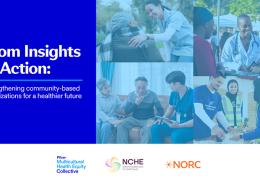Equity in Advanced Prostate Cancer Care Begins with Changing the Conversation

Prostate health is not a popular topic of conversation. Even in healthcare settings, patients and providers might be hesitant to discuss prostate health or cancer screening. But talking openly is not only the key to destigmatizing an important topic, it’s one of the first steps in addressing global health inequities that impact those diagnosed with prostate cancer.
“In the past 10 years, we have seen advances in the treatment of advanced prostate cancer (aPC), but some people are still being left behind,” says Carol Choi, Global Health Equity Lead, Global GU and Lung Cancer Organization at Pfizer. “We can’t fully celebrate the successes until we address the barriers that make it harder for some people to access screening, testing, treatment, and equitable care.”
Basic Obstacles to Advanced Prostate Cancer Treatment
Prostate cancer is the second most common cancer among those assigned male at birth with more than 250,000 new cases diagnosed in the United States each year.1,2 It’s also the second leading cause of cancer death in the U.S. for the same demographic—more than 34,000 each year.2
When the disease has not spread beyond the prostate or surrounding lymph nodes, the five-year survival rate is more than 99%.3 But, too often, those assigned male at birth are less likely to participate in their healthcare by going to a primary care physician, and they're less likely to be aware of medical screenings that they should consider as they age.3
A 2021 survey found that 25% of all men didn't even have a healthcare provider (among Latino men, the number was 42%)4 and one-third of men believed they didn't need annual screenings, according to a separate national poll.5 Transgender women are also at risk of prostate cancer and those who haven't had gender-affirming surgery and are not taking gender-affirming hormone therapy have the same risks as CIS gender men.6
Once diagnosed with aPC, patients may feel undervalued in the healthcare system, embarrassed by their diagnosis, or fearful that discussing their disease could affect their relationships and perceptions of their masculinity.7
“Financial and emotional distress, physical and mental ailments, geographic and social isolation, distrust, fear, and ignorance are just some of the common barriers to accessing timely healthcare that advanced prostate cancer patients face,” says Dan George, MD, Professor of Medicine and Surgery at Duke University School of Medicine.
Access Barriers for Underrepresented Communities
To complicate matters, race, age, socioeconomic status, geographic location, and insurance status have been shown to play a role in treatment decisions and clinical outcomes for aPC.8
A 2017 survey conducted by researchers at the Brown University School of Public Health found that healthcare providers in the U.S. were the least likely to discuss the advantages and disadvantages of prostate cancer screenings with low-income, uninsured, or Hispanic patients.1
Separate research published in Family Medicine in 2022 found that fewer than 30% of physicians talked to Black patients about their prostate cancer risk. Yet Black patients have a higher incidence of prostate cancer and mortality rates that are more than double than that of white patients.9
Among those who are gay or bisexual, a diagnosis of aPC was linked to lower health-related quality of life—including worse urinary and hormonal function and higher rates of mental health disorders—compared to heterosexual people diagnosed with the disease.10
A link exists between socioeconomic status and aPC outcomes, as well. A lower income is associated with lower rates of prostate cancer detection, longer wait times for treatment, and poorer treatment outcomes, including higher mortality rates.11
Living in rural and disadvantaged areas was also associated with worse cancer outcomes. Rural residents diagnosed with aPC were less likely to receive treatment than those living in urban areas, and limited access to care, including the lack of a practicing urologist in 76% of rural counties in the United States, increased prostate cancer mortality rates.12
“Scientific advances are only truly impactful if the patients in need are able to receive the latest treatment when they need it," says Dr. George.
De-Stigmatizing Prostate Cancer
In the last decade, survival outcomes of aPC have improved. Lucile Serfass, who is Senior Director, Global Medical Affairs at Pfizer, attributes this to the development of several novel agents and combining multiple therapeutic strategies.
"These advances have improved outcomes in advanced prostate cancer, which is, of course, good news for patients,” says Serfass. “But scientific innovation is only part of the equation. All patients should have the opportunity to access and appropriate care. That is why understanding the impact of these inequities is so important."
Simply talking about prostate cancer helps to destigmatize the disease. Choi encourages community members, caregivers, and loved ones to start conversations about the disease. “It’s important to be aware, to get educated, to get checked, to go to the doctor," she says, "because if we as a society can more openly talk about it, then those who are diagnosed will feel more comfortable talking about it, as well.”
That's why in June 2022 Pfizer launched Change the Conversation in aPC—to help normalize conversations about advanced prostate cancer, understand challenges that contribute to health inequities, partner with the cancer community to address the complex barriers that can lead to disparities in advanced prostate cancer and provide resources to patients to help them understand their disease and talk with their physicians
“There is no replacement in our health system for the role of human interaction,” Dr. George adds. “When it comes to health inequities, care teams need to embrace health communication on the patient’s terms, in their community, with constituents who relate to their values.”
Addressing healthcare inequities can result in fairer outcomes for everyone diagnosed with aPC. But it requires a global commitment to acknowledging the barriers to screening and treatment and working toward solutions.
“A lot of these barriers are structural or systemic issues, and there is no one-size-fits-all solution,” Choi says. “It is necessary for everyone to contribute to addressing inequity. It can’t be solved by the patients, or healthcare providers, or policymakers, or medical institutions alone. It really takes everybody to get involved to make an impact.”
References:
- Turini, G.A., Gjelsvik, A. and Renzulli, J.F. The State of Prescreening Discussions About Prostate-specific Antigen Testing Following Implementation of the 2012 United States Preventive Services Task Force Statement. Urology. https://www.goldjournal.net/article/S0090-4295%2817%2930246-7/fulltext. Published March 18, 2017. Accessed October 4, 2022.
- American Cancer Society. Key Statistics for Prostate Cancer. https://www.cancer.org/cancer/prostate-cancer/about/key-statistics.html. Revised January 12, 2022. Accessed October 4, 2022.
- American Cancer Society. Survival Rates for Prostate Cancer. https://www.cancer.org/cancer/prostate-cancer/detection-diagnosis-staging/survival-rates.html. Revised March 1, 2022. Accessed October 4, 2022.
- Kaiser Family Foundation. "Men Who Report Having No Personal Doctor/Healthcare Provider by Race/Ethnicity." https://www.kff.org/racial-equity-and-health-policy/state-indicator/men-who-report-having-no-personal-doctorhealth-care-provider-by-raceethnicity/?currentTimeframe=0&selectedDistributions=all-men--white--black--hispanic--asian-native-hawaiian-or-pacific-islander--american-indian-alaska-native&selectedRows=%7B%22wrapups%22:%7B%22united-states%22:%7B%7D%7D%7D&sortModel=%7B%22colId%22:%22Location%22,%22sort%22:%22asc%22%7D. Accessed October 11, 2022
- Orlando Health. "Orlando Health Survey Reveals Alarming Health Habits of Men." https://www.orlandohealth.com/content-hub/orlando-health-survey-reveals-alarming-health-habits-of-men. Published June 21, 2022. Accessed October 11, 2022.
- Tanaka, M.B., Shasta, K., Burn, J. et al. Prostate cancer in transgender women: What does a urologist need to know? BJU International. https://pubmed.ncbi.nlm.nih.gov/34157213/. Published July 21, 2021. Accessed October 11, 2022.
- Chambers, S.K., Hyde, M.K., Laurie, K. et al. Experiences of Australian men diagnosed with advanced prostate cancer: a qualitative study. BMJ Open. https://bmjopen.bmj.com/content/8/2/e019917. Published February 28, 2018. Accessed October 4, 2022.
- Gardner, U., McClelland, S. and Delville, C. Disparities in the Utilization or Radiation Therapy for Prostate Cancer Treatment in the United States: A Comprehensive Review. Advances in Radiation Oncology. https://www.advancesradonc.org/article/S2452-1094(22)00050-1/fulltext. Published July 1, 2022. Accessed October 31, 2022.
- Shungu, N., Diaz, V.A., Perkins, S. et al. Physician Attitudes and Self-reported Practices Toward Prostate Cancer Screening in Black and White Men. Family Medicine. https://pubmed.ncbi.nlm.nih.gov/35006597/. Published January 2022. Accessed October 4, 2022.
- Haggart, R., Polter, E. Ross, M. et al. Comorbidity Prevalence and Impact on Quality of Life in Gay and Bisexual Men Following Prostate Cancer Treatment. Sexual Medicine. https://www.ncbi.nlm.nih.gov/pmc/articles/PMC8766256/. Published October 8, 2021. Accessed October 4, 2022.
- Tomic, K. Ventimiglia, E., Robinson, D. et al. Socioeconomic status and diagnosis, treatment, and mortality in men with prostate cancer. Nationwide population‐based study. International Journal of Cancer. https://www.ncbi.nlm.nih.gov/pmc/articles/PMC5947133/. Published February 2, 2018. Accessed October 4, 2022.
- Maganty, A., Sabik, L.M., Sun, Z.J. et al. Undertreatment of Prostate Cancer in Rural Residents. Journal of Urology. https://www.ncbi.nlm.nih.gov/pmc/articles/PMC7098431/. Published August 20, 2019. Accessed October 4, 2022.
![]()





